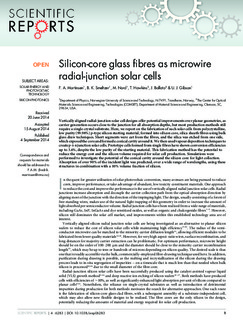| dc.contributor.author | Martinsen, Fredrik A | |
| dc.contributor.author | Smeltzer, Benjamin | |
| dc.contributor.author | Nord, Magnus Kristofer | |
| dc.contributor.author | Hawkins, Thomas A. | |
| dc.contributor.author | Ballato, John | |
| dc.contributor.author | Gibson, Ursula | |
| dc.date.accessioned | 2015-01-06T09:38:30Z | |
| dc.date.accessioned | 2016-04-20T14:12:16Z | |
| dc.date.available | 2015-01-06T09:38:30Z | |
| dc.date.available | 2016-04-20T14:12:16Z | |
| dc.date.issued | 2014 | |
| dc.identifier.citation | Scientific Reports 2014, 4 | nb_NO |
| dc.identifier.issn | 2045-2322 | |
| dc.identifier.uri | http://hdl.handle.net/11250/2386570 | |
| dc.description.abstract | Vertically aligned radial-junction solar cell designs offer potential improvements over planar geometries, as carrier generation occurs close to the junction for all absorption depths, but most production methods still require a single crystal substrate. Here, we report on the fabrication of such solar cells from polycrystalline, low purity (99.98%) p-type silicon starting material, formed into silicon core, silica sheath fibres using bulk glass draw techniques. Short segments were cut from the fibres, and the silica was etched from one side, which exposed the core and formed a conical cavity around it. We then used vapour deposition techniques to create p-i-n junction solar cells. Prototype cells formed from single fibres have shown conversion efficiencies up to 3.6%, despite the low purity of the starting material. This fabrication method has the potential to reduce the energy cost and the silicon volume required for solar cell production. Simulations were performed to investigate the potential of the conical cavity around the silicon core for light collection. Absorption of over 90% of the incident light was predicted, over a wide range of wavelengths, using these structures in combination with a 10% volume fraction of silicon. | nb_NO |
| dc.language.iso | eng | nb_NO |
| dc.publisher | Nature Publishing Group | nb_NO |
| dc.rights | Navngivelse 3.0 Norge | * |
| dc.rights.uri | http://creativecommons.org/licenses/by/3.0/no/ | * |
| dc.title | Silicon-core glass fibres as microwire radial-junction solar cells | nb_NO |
| dc.type | Journal article | nb_NO |
| dc.type | Peer reviewed | nb_NO |
| dc.date.updated | 2015-01-06T09:38:30Z | |
| dc.source.volume | 4 | nb_NO |
| dc.source.journal | Scientific Reports | nb_NO |
| dc.identifier.doi | 10.1038/srep06283 | |
| dc.identifier.cristin | 1151393 | |
| dc.description.localcode | This work is licensed under a Creative Commons Attribution-NonCommercial-NoDerivs 4.0 International License. The images or other third party material in this article are included in the article's Creative Commons license, unless indicated otherwise in the credit line; if the material is not included under the Creative Commons license, users will need to obtain permission from the license holder in order to reproduce the material. To view a copy of this license, visit http://creativecommons.org/licenses/by-nc-nd/4.0/ | nb_NO |

